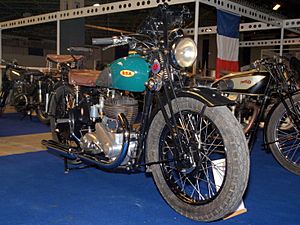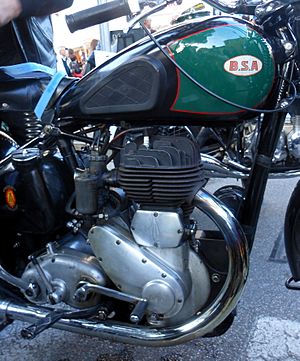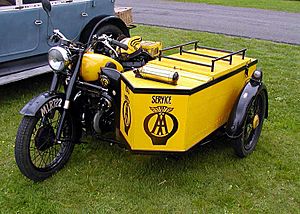BSA M20 facts for kids
 |
|
| Manufacturer | Birmingham Small Arms Company |
|---|---|
| Production | 1937–1955 |
| Engine | 496cc single cylinder side valve 4 stroke |
| Bore / stroke | 82 mm × 94 mm (3.2 in × 3.7 in) |
| Power | 13bhp @4,200 rpm |
| Transmission | 4 Speed / chain |
| Fuel capacity | 3 gallons |
The BSA M20 is a famous British motorcycle. It was made by the Birmingham Small Arms Company (BSA) in Birmingham. Even though it wasn't thought to be very good at first in 1936, the M20 became one of the most important motorcycles used by the British military. It was also the most common type made for World War II, with 126,000 bikes in service. Many of these tough motorcycles are still used around the world today!
Contents
How the M20 Was Developed
When World War II began, BSA was the biggest motorcycle maker in Britain. They had a long history of supplying weapons to the armed forces. The BSA M20 was designed by Val Page. Its development started in 1937. It was built to be a strong motorcycle that could carry a sidecar. It had a simple 500 cc engine that was good at pulling heavy loads.
The first models, called K-M20, were made in 1939. They used parts from regular civilian bikes but added military features. These included a large headlight with a special cover for blackouts. They also had special caps for the fuel and oil tanks. Early military M20s had a long kickstand on the side. BSA sent these K-M20 models to countries like Sweden, South Africa, and India.
The Factory Bombing
Workers making the M20 were affected by an air raid on the BSA factory in Birmingham. This happened on the night of November 19, 1940. The factory was a main target for the German air force, the Luftwaffe. Bombs hit the factory, causing a lot of damage and starting fires.
Many workers were killed or hurt in the attack. BSA's own fire brigade helped put out the fires. Even though a lot of the factory was destroyed, BSA had 67 other factories. This meant they could move the work to other places. Because of this, making the BSA M20 motorcycles continued without stopping.
Changes and Upgrades
From October 1939, the K-M20 was renamed the W-M20. It was changed to have stronger front forks and a different rear mudguard. During 1940, some regular M20 bikes were bought by the military and painted in army colors.
In 1941, the number plates were removed. Between 1941 and 1942, soldiers using the bikes in North Africa found they needed to adjust the front fork dampers easily. So, special knobs were added for this. The large headlight was replaced with a smaller one that had a special cover for blackouts.
From 1942, there was a shortage of rubber. So, the handlebar grips and foot pegs were made from metal covered in canvas. Production became standard, with only small changes until the end of World War II. By early 1942, a new large rack was added to the back to hold military bags. This meant moving the kickstand. In 1943, more changes were made. These included a new engine shield and a large air filter on top of the fuel tank. This filter helped the bike work better in dusty places. In 1945, a push-button switch was added for the headlight.
Military Service
The M20 was first tested by the military in 1936. It failed because its engine wore out too quickly. In 1937, three more M20s were tested. Two of them just barely passed tough 10,000-mile tests. A small number of M20s were ordered in 1938.
People said the M20 was heavy and slow, and didn't have much ground clearance. But it was saved because it was very reliable and easy to fix. As the need for military transport grew, more and more M20s were ordered. Most BSA M20 motorcycles were used by the British Army. However, the Royal Navy and the Royal Air Force also used them.
The M20 was designed as a general-purpose motorcycle. It was used for escorting convoys and carrying messages. It saw action in almost every part of the war. After the war, the BSA M20 continued to be used by the military. This was partly because it was cheap and spare parts were easy to find. It also proved to be very tough after six years of hard use without major problems.
Civilian Versions
After the war, the BSA M20 became a reliable and affordable way for people to get around. BSA repainted the military bikes from khaki to black. They became very popular, especially when used with a sidecar. The Automobile Association (AA), a roadside assistance company, ordered many of them. Their yellow and black M20 motorcycles with sidecars became a common sight on British roads.
The engine from the wartime models continued to be made until 1951. After that, a new cylinder head was introduced, but the bike stayed mostly the same. In the 1950s, it became harder to find spare parts. Also, newer, more modern motorcycles with two cylinders started to appear. So, the M20 was stopped in 1956. However, a larger 600cc version, the M21, was made until 1963.
The 112 MPH BSA M20
People who love motorcycles often restore the M20 to look just like it did during the war. But some specialists have also made M20s for speed races!
A 1938 BSA M20, ridden by Bill Jenkins from Dallas, reached a top speed of 108 mph at Bonneville Salt Flats. This made it the fastest M20 in the world! The original engine was changed a lot and used a special fuel called nitrous oxide. Even with all these changes, the motorcycle still had its original long kickstand.
In October 1995, another M20, ridden by Pat Jeal, reached an even faster speed of 112 mph. This happened at a disused airfield in Yorkshire, England. This M20 used special parts and a mix of methanol and acetone as fuel.
See also
- List of motorcycles of the 1930s
- List of motorcycles of the 1940s
- List of motorcycles of the 1950s



